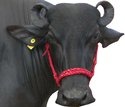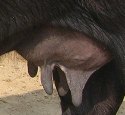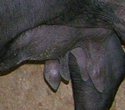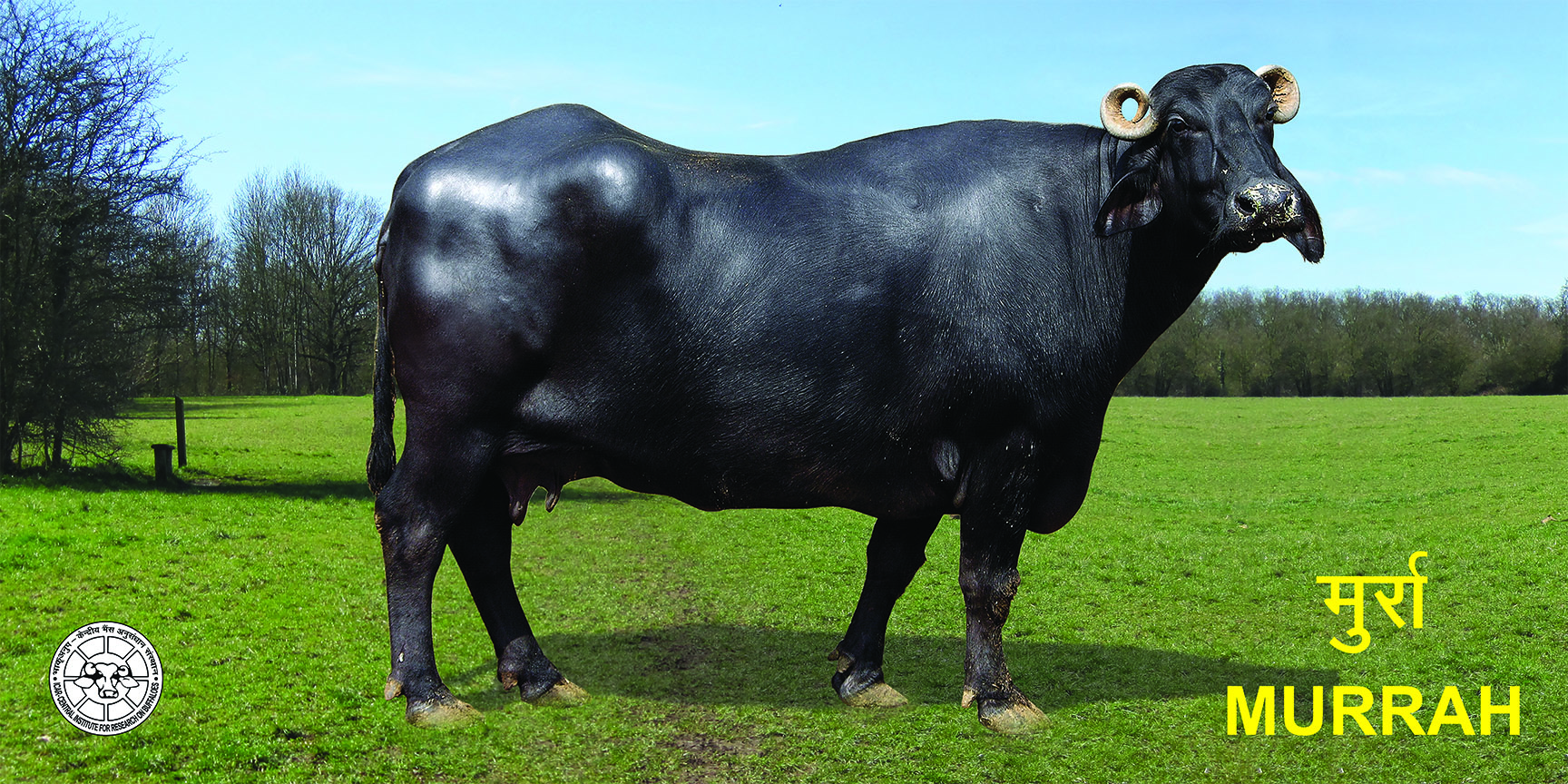Murrah
- Origin & Breeding Tract
- Population
- Physical Characteristics
- Biometry
- Production Traits
- Reproduction Traits
- Housing Management & Practices
Buffaloes, in the northwest region of India have long been selected for high milk production and curled horns. These were named as ‘Murrah’ which means ‘curled’. These buffaloes were also named as ‘delhi’ referring to the center of their origin.

Its home tract stretches around the southern parts of Haryana comprising the districts of rohtak, Jind, Hisar, Jhajhar, Fatehabad, Gurgaon and the Union Territory of Delhi. However, this breed has spread to almost all parts of the country and is being bred either in pure form or is being used as improver breed for grading up local buffaloes. In fact, this breed has even found and important place in the livestock industry of many developing countries like Bulgaria, Philippines, Malaysia, Thailand, China, Indonesia, Bangladesh, Nepal, former USSR, Myanmar, Vietnam, Brazil and Shri Lanka.
The native tract of the breed covering parts of Haryana lies between 28°15´ and 30°0’ North latitude, and 75°45’ and 70°80’ East longitude. Soils of the area are mostly light-textured, sandy and loamy. In some parts of the breeding tract surface soils are light in texture but available nitrogen, and medium to high in phosphorus and nitrogen.
The breeding tract has relatively hot and dry climate. Maximum temperature goes as high as 45°C during summer. Minimum temperature may reach near freezing point in winter with frost for a few days
Some of the important characteristics is described as follows: –
|
Body color |
The color is jet black. Rarely white markings on face and leg extremities may be there, but are not preferred |
   |
|
Horns |
Different from other breeds; short, tight, turning backward and upward and finally spirally curving inward. The horns should be somewhat flattened. As the age advances the horns get loosened slightly but spiral curves increase. |
  |
| Marking Eye | Eyes are Black , active and prominent in females but slightly shrunken in males and should not be walled i.e. cornea should not have whiteness. |   |
| Tail | Long reaching upto fetlock joint with black or white (max. 6 inches) switch. |   |
| Body | Sound built, heavy and wedge shaped. |   |
| Head | Medium |   |
|
Face Neck |
Medium Neck is long and thin in females and thick and massive in males. |
  |
| Ear | Ears are short, thin and alert. |   |
|
Limbs Skin |
Short but strong built. Soft, smooth with scanty hair as compared to other buffaloes. |
  |
| Udder | Fully developed, drooping with equally distributed teats over the udder. |   |
| Teats | Teats are long, and places uniformly wide apart but hind teats are longer than fore teats. |   |
Averages of length, height and heart girth of adult males are 150, 142 and 220 cm, and of females 148,133 and 202cm respectively. Average birth weight of male calves is 31.7 kg and that of female calves is 30kg. Adult body weight ranges from 450 to 800kg (average 567 kg) in males and from 350 to 700 kg (average 516kg) in females.
Body weight and Growth Rate
The mean values of body weight at birth, 6, 9,12,18,24 months and at first calving reported by various workers are presented below.
| Stage | Mean +- S.E(Kg) | Mean +- S.E(Kg) |
| At Birth | ||
| 3 months | ||
| 6 months | ||
| 9 months | ||
| 12 months | ||
| 18 months | ||
| 24 months | ||
| At first calving |
Morphological Characteristics
Average values of morphological traits of Murrah buffaloes like body length, height at withers, heart girth and adult weight reported by various workers are given in the following table.
| characteristics | Sex | Average |
| Body Length(cm) | Male
Female |
150
148 |
| Height at withers(c) | Male
Female |
142
133 |
| Hearth Girth(cm) | Male
Female |
220
202 |
| Birth Weight(Kg) | Male
Female |
31.7
30 |
| Adult weight(Kg) | Male
Female |
400-800
350-700 |
Milk yield varies from place to place depending upon the management practices and environmental conditions under which animals are reared. Large herds have shown average yields as 1800 kg.
| No. of Observations | Mean±S.E | References |
| 1352 | 2014.00±52.00 | Singh et al (1990) |
| 412 | 1647.00±44.00 | Gaj bhiye & Tripathi (1991) |
| 716 | 1737.00±64.92 | Raheja (1992) |
| 424 | 1869.70±27.91 | Sahana (1993) |
| 114 | 1832.16±79.28 | Shabade et al (1993) |
| 105 | 1067.32±60.12 | Neog et al.(1993) |
| 683 | 1694.36±27.71 | Dhara (1994) |
| 1647 | 1621.06±28.10 | Dutt and Taneja (1994a) |
| 320 | 1658.95±26.28 | Narula et al (1994) |
| 146 | 1466.00±89.00 | Pundir (1994) |
| 450 | 1482.06±39.98 | Muridhar & Deshpande (1995) |
| 917 | 1631.52±21.18 | Sharma (1996) |
| 615 | 1693.00±29.70 | Sethi & Khatkar (1997) |
| 683 | 1748.70±26.20 | Jain & Sadana ( 1998) |
| 832 | 1894.94±21.31 | Nath (1998) |
| 396 | 1646.70±44.20 | Gajbhiye & Tripathi (1999) |
| 289 | 1618.70±38.58 | Kumar (2000) |
Lactation Length
Buffaloes with longer lactation length are generally high milk producers provided they are given sufficient dry period for replenishment before subsequent calving.
First lactation length in murrah buffaloes.
| No. of Observations | Mean±S.E | References |
| 412 | 313.00±07.00 | Gaj bhiye & Tripathi (1991) |
| 716 | 324.20±02.54 | Raheja (1992) |
| 421 | 302.25±03.10 | Ravindra (1992) |
| 114 | 357.90±12.99 | Shabade et al (1993) |
| 105 | 274.60±12.60 | Neog et al.(1993) |
| 404 | 306.00±04.00 | Dass & Sharma (1994) |
| 683 | 289.55±03.68 | Dhara (1994) |
| 146 | 366.00±18.00 | pundir (1994) |
| 917 | 331.30±03.24 | Sharma (1996) |
| 615 | 335.50±05.10 | Sethi & Khatkar (1997) |
| 832 | 333.39±06.70 | Nath (1998) |
| 396 | 313.70±06.70 | Gajbhiye and Tripathi (1999) |
| 289 | 319.50±04.97 | Kumar (2000) |
Peak Yield
Similar to other traits, there is variation in peak yield as well but minimum peak yield of herds is more than 7 kg.
| No. of Observations | Mean±S.E | References |
| 1352 | 9.61±0.18 | Singh et al (1990) |
| 385 | 8.59±0.25 | Gaj bhiye & Tripathi (1991) |
| 210 | 7.10±0.10 | Sharma et al (1992) |
| 399 | 9.64±0.14 | Sahana (1993) |
| 369 | 8.00±0.10 | Rao & Rao (1994) |
| 917 | 7.10±0.10 | Sharma (1996) |
| 615 | 7.90±0.10 | Sethi & Khatkar(1997) |
| 289 | 7.93±0.16 | Kumar (2000) |
Lifetime Milk Yield
Buffaloes are not kept in the herd until their natural death, so calculation of milk production for whole life is not feasible in practice. Different criteria had been used for estimating lifetime milk production by different authors. Murrah buffaloes are known for their longevity and persistent yield even in later lactations.
| No. of Animals | Mean±S.E (kg) | Level of lifetime production | References |
| 309 | 4335.39±103.37 | Up to 4 lactations | Biradar et al (1991) |
| 1647 | 9993±338 | Up to disposal | Dutt & Taneja (1994b) |
| 210 | 9187.1±101.40 | Up to 5 lactations | Sharma et al (1992) |
| 145 | 4474.61 | Up to 5 lactations | Mahdy (1993) |
| 917 | 7834.4±188.6 | Up to 4 lactations | Alli et al (2000) |
| 2107 | 5588±40.2 | Up to 3 lactations | Kuralkar & Raheja (2000) |
Average age at first calving is 1,319 days and dry period averages are 187.6 days in the first lactation and 154.8days for overall lactations. Service period averages 177.1 days in first parity and 136.3 days in overall parities.First calving interval varies from 455 to 632 days (averages 488.1days), and overall calving interval varies from 430 to 604 days (average 452.9 days). Number of service per conception varies from 1.75 to 2.15 9 average (1.93)
Reproductive performance of Murrah Buffalo at CIRB campus, Hisar
1. Male
a) Age at puberty (months)
2. Female
a) Age at puberty (months)
b) Age at First Calving (months)
Average ages at first calving reported by various workers are presented below:
| No. of Observations | AFC (days) | References |
| 478 | 1485.67±15.25 | Sharma & Singh (1990) |
| 412 | 1362.00±11.00 | Gaj bhiye & Tripathi (1991) |
| 716 | 1335.17±08.01 | Raheja (1992) |
| 421 | 1319.48±09.11 | Ravindra (1992) |
| 701 | 1316.46±06.81 | Dhara(1994) |
| 716 | 1374.48±15.99 | Gupta et al(1994) |
| 320 | 1550.60±13.03 | Narula et al (1994) |
| 146 | 1581.00±69.00 | pundir (1994) |
| 628 | 1381.26±0626 | Dass (1995) |
| 917 | 1602.82±08.53 | Sharma (1996) |
| 685 | 1374.23±10.37 | Jain and Sadana (1998) |
| 832 | 1330.79±07.42 | Nath (1998) |
| 412 | 1362.30±10.90 | Gajbhiye and Tripathi (1999) |
| 289 | 1618.83±21.25 | Kumar( 2000) |
C) Service Period(days)
Even though a period of 60 days is allowed as post-partum rest, Murrah in general has a long service period of 5-6 months.
The average first service period reported by various workers are presented in the following table.
| No. of Observations | Mean±S.E | References |
| 716 | 232.09±10.37 | Gupta et al (1994) |
| 465 | 143.96±05.85 | Dhara (1994) |
| 917 | 291.85±07.14 | Sharma (1996) |
| 502 | 149.50±07.90 | Jain & Sadana ( 1998) |
| 832 | 143.41±03.97 | Nath (1998) |
| 243 | 154.70±05.00 | Gaj bhiye & Tripathi (1999) |
| 289 | 177.83±4.70 | Kumar (2000) |
d) Dry Period (days)
Murrah has an average dry period of six months
The average first dry period reported by various workers are presented in the following table.
| No. of Observations | Mean±S.E | References |
| 1154 | 194.87±04.60 | Singh et al (1990) |
| 412 | 146.00±05.00 | Gaj bhiye & Tripathi (1991) |
| 314 | 142.02±04.18 | Sahana (1993) |
| 469 | 145.13±04.21 | Dhara (1994) |
| 716 | 184.83±07.12 | Gupta et al (1994) |
| 103 | 212.10±45.00 | pundir (1994) |
| 1647 | 187.10±05.66 | Dutt and Taneja (1995) |
| 917 | 265.12±05.96 | Sharma (1996) |
| 832 | 137.76±02.81 | Nath (1998) |
| 277 | 145.70±05.00 | Gaj bhiye & Tripathi (1999) |
| 289 | 167.00±0.476 | Kumar (2000) |
e) Calving interval (months)
Calving interval has direct bearing both on reproduction and production efficiencies.
| No. of Observations | Mean±S.E | References |
| 412 | 455.00±08.00 | Gaj bhiye & Tripathi (1991) |
| 716 | 505.66±05.51 | Raheja (1992) |
| 421 | 451.36±06.38 | Ravindra (1992) |
| 316 | 448.26±05.63 | Sahana (1993) |
| 471 | 456.22±05.24 | Dhara (1994) |
| 716 | 492.40±11.61 | Gupta et al (1994) |
| 337 | 508.91±07.04 | Dass (1995) |
| 917 | 581.14±07.15 | Sharma (1996) |
| 832 | 462.65±04.53 | Nath (1998) |
| 265 | 455.40±07.90 | Gaj bhiye & Tripathi (1999) |
| 289 | 485.13±04.49 | Kumar (2000) |
In the breeding tract, these buffaloes are kept in a mixed type of housing syatem. The buffaloes are tied to a tree or a pole in the open, but shelter is provided during extreme weather conditions. House are well ventilated and mostly made up of Pucca walls with kutchha floor.
Feeding
Animals are mostly stall fed. Berseem, oat and mustard are the green fodders fed in rabi, and pearl millet, sorghum and cluster bean in Kharif. In lean season Murrah animals are maintained on wheat and pulse straws in conjunction withoilcakes and other concentrates. Mostly, women are engaged in buffalo rearing (80%), and all the activities pertaining to feeding, milking, cleaning etc. are looked after by them. Calves are not weaned. Very few farmers rear bulls exclusively for breeding purpose. Natural service is mostly practiced in the field.

